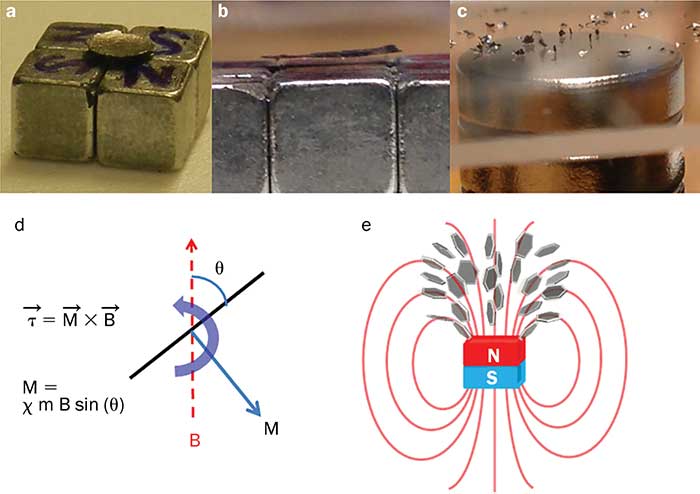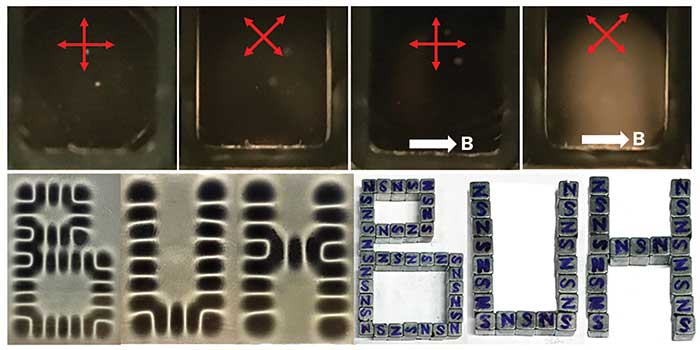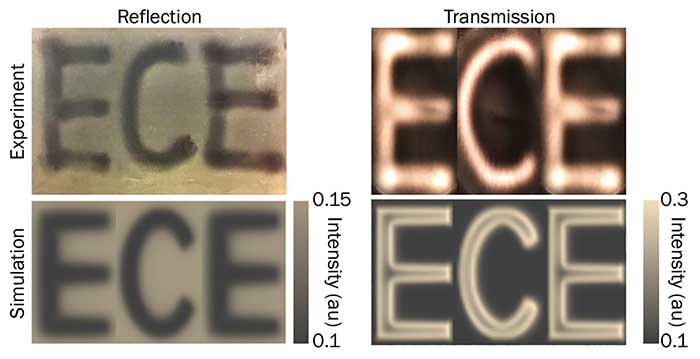New method controls the orientation of individual nanomaterials, which may soon lead to advances in LEDs, solar cells, smart windows and optical isolators.
JIMING BAO AND FENG LIN, UNIVERSITY OF HOUSTON, AND JONATHAN HU, BAYLOR UNIVERSITY
Nanomaterials, such as nano-wires and nanotubes, are designed to have quantum confinement in one or two dimensions so that their properties in other dimensions can be engineered, differing from that of their corresponding bulk material. As such, the unique and superior properties of nanomaterials are always associated with their shape and symmetry.
Consider graphene. A single layer of graphene absorbs about 2.3 percent of incident light, but this is only valid for incident light normal to the graphene plane; the absorption becomes zero when the electrical field of light is perpendicular to the plane. Understanding the anisotropic properties of nanomaterials is important for device applications with composite materials or functional devices that involve hundreds of thousands of individual nanomaterials. A case in point: If suspended graphene flakes in a solvent are randomly oriented, they appear isotropic macroscopically, and
unique properties of graphene disappear. Only when they are aligned can their unique properties be utilized and transferred to large-scale devices.

Figure 1. Levitation and rotation of graphite or graphene flakes by magnetic field. Magnetic levitation of a piece of highly ordered pyrolytic graphite (HOPG) on neodymium magnets with alternating up-facing poles (a). Magnetic levitation of a disk made of multilayer graphene flakes (b). Alignment of multilayer graphene flakes with a vertical magnetic field on the surface of a neodymium magnet (c). Torque experienced by a graphene flake under a uniform magnetic field (d). Schematic of graphene flakes aligned with magnetic field of a magnet (e). Courtesy of Jiming Bao, University of Houston.
The orientational control and assembly of nanomaterials is an integral part of nanotechnology that has led to recent research on the structured assembly of nanowires and nanotubes. The alignment of graphene and related device applications has also been reported recently by several groups, but it was achieved by using either shear stress or magnetic nanoparticles. The alignment of graphene by magnetic field has been theoretically studied, but a large magnetic field of 9 Tesla was required.
In contrast, the authors recently demonstrated magnetic alignment of graphene using a weak field from commercial neodymium magnets1 — results made possible by large micro-sized flakes and their excellent diamagnetic susceptibility.
Magnetic response
Graphene and graphite are typically considered nonmagnetic materials, but they exhibit the highest diamagnetic susceptibility, second only to superconductors. Such large diamagnetism is a result of the magnetic response of in-plane orbital electrons, which circle around the external field due to the so-called Lorentz force, and subsequently induce a magnetic field in an opposite direction to the applied field, resulting in a repelling force between a magnet and graphene.

A convenient and interesting demonstration of a strong diamagnetism is magnetic levitation (Figure 1a). Such levitation is made possible by another unique property: very low density of graphite. Graphene’s magnetic susceptibility can be tested in the same way. Figure 1b shows the levitation of a graphene disk made of multilayer graphene flakes by drying of graphene suspension. The levitation indicates that the sample is dominated by the intrinsic diamagnetism as opposed to potential ferromagnetic impurities. Note that a stable levitation cannot be achieved by a single magnet. When a graphene flake is placed on a magnet, it will either lay flat on the surface, or stand on its edge (Figure 1c). Such response is a consequence of anisotropic diamagnetism (Figure 1d). A vertical magnetic field induces a magnetic moment M, which is normal to graphene surface and points opposite to B. M = m χ B sin(θ), where m is the mass of graphene flake, χ is the diamagnetic susceptibility. The torque experienced by the flake is given by the equation above. Based on this equation, the torque always makes θ smaller; in other words, it turns the flake aligned with the magnetic field. The torque is zero when θ is zero and 90°, and it reaches the maximum at 45°. Note the repulsive force is zero in such a uniform magnetic field, and the orientation is not stable when the flake is perpendicular to the field. Figure 1e illustrates the alignment of graphene flakes with the magnetic field of a magnet. It is important to point out that the total control of flake orientation in a three-dimensional arrangement requires another perpendicular magnetic field.
The macroscopic alignment of suspended graphene flakes can be confirmed using birefringence imaging. This is because a flake is optically anisotropic like a liquid crystal rod molecule. The top panels in Figure 2 show the appearance of birefringence after the application of a lateral magnetic field. The flakes are randomly oriented and the suspension is optically isotropic without magnetic field so that optical transmission through two cross-polarized filters is very weak.

Figure 2. Birefringence and magnetic field sensing/display of aligned graphene flakes. Optical transmission of suspended few-layer graphene through two cross-polarized filters without and with a magnetic field (top). Red arrows indicate direction of polarization. Letters “B”, “U” and “H” of magnets displayed by a suspension of multilayer graphene flakes (bottom). Courtesy of Jiming Bao, University of Houston.
Graphene flakes as reflective mirrors
Maximum transmission when two polarizers are rotated 45° relative to the magnetic field confirms the alignment of flakes with the field. The magnetic alignment can be most easily observed where no special light illumination and polarizers are needed (Figure 2). The bright and dark features correspond to the region where the magnetic field between two magnets is parallel with the surface and the region where the field on the surface of magnets is perpendicular to the surface, respectively. The bright and dark contrast is due to anisotropic optical property of graphene flakes. Here a flake, especially a multilayer flake, can be treated as a reflective mirror. When its surface faces the viewer, it appears bright, but it appears dark when its edge is toward the viewer. Such magnetic field sensing and display remind us of iron filings, but graphene clearly has advantages such as faster response, no aggregation and higher spatial resolution.
The strong orientational response to magnetic field and orientation-dependent optical reflectance and transmission allow us to design a graphene magnetic writing board by simply enclosing graphene suspension between two glass windows. The letters “ECE” (Figure 3) are written with a magnet bar made of stacked magnets. Letters are very visible in reflection and transmission; the results agree with simulation on the bottom image. Note that both bright pattern and dark pattern with strong transmission and low reflection originate from the same causes: low reflection and absorption when a graphene flake is facing perpendicular to the incident light. Similar optical anisotropy and display applications have also been observed in graphene oxide2.

Figure 3. Reflective and transmissive displays of “ECE” written by a magnet rod made of stacked cubic neodymium magnets seen in Figures 1 and 2. Optical pictures (top), simulations.(bottom). Courtesy of Jiming Bao, University of Houston.
The strong and distinctive optical reflection and transmission have demonstrated the power of aligned graphene. Such macroscopic properties are expected in all other properties of graphene such as electrical, thermal and mechanical properties. Figure 4 shows two alignment configurations of graphene flakes with respect to the supporting substrate. Vertically aligned graphene flakes exhibit weak optical reflection and strong transmission. When flakes are aligned parallel to the substrate, they are highly reflective. These properties enable them to find wide photonic applications such as optical isolators, lasers,
light-emitting devices, solar cells, smart windows and smart screens. In an energy-efficient building, smart windows will block more light in summer when additional light or heat should be minimized. Smart windows will transmit more light in winter, when more light and heat is preferred from the sun. In addition, graphene-based screens can block the view from unwanted personnel in a meeting with proprietary information; the same screen should be converted to transparent in a normal business environment. Because other properties such as thermal and electrical conductivity are also strongly dependent on flake orientation, aligned flakes can be used for electromagnetic shielding, transparent conductive windows and thermal interface materials. Composite with aligned graphene as nanofillers will show very anisotropic mechanical and elastic properties in addition to other above mentioned properties.

Figure 4. Two alignment configurations for device applications. Flakes perpendicular to the substrate (left). Flakes parallel with the substrate (right). Courtesy of Jiming Bao, University of Houston.
Uniform size required
Certainly the quality of constituent graphene flakes will affect the overall performance and functionality of graphene assembly. For most applications discussed above, we need graphene flakes with uniform size, thickness and high magnetic susceptibility. Wet exfoliation remains as a viable technique to produce graphene flakes in a large quantity, but such produced flakes are not uniform and are often mixed with graphite particles and aggregates. More controlled exfoliation and post-purification techniques are needed to produce pure and uniform flakes, which are more important for a wide range of photonics applications such as graphene liquid crystals, magneto-optic switch, nonlinear and polarizing optical devices3. The orientation control of graphene by magnetic field also opens up applications in other fields where graphene flakes can be used as mechanical actuators, material mixing or transport.
Meet the authors
Jiming Bao and Feng Lin are with the department of electrical and computer engineering at the University of Houston, and the Institute of Fundamental and Frontier Science at the University of Electronic Science and Technology of China; emails: [email protected] and [email protected]. Jonathan Hu is with the department of electrical and computer engineering at Baylor University in Waco, Texas; email: [email protected].
References
1. F. Lin et al. (2017). Orientation control of graphene flakes by magnetic field: Broad device applications of macroscopically aligned graphene. Adv Mater, Vol. 29, 1604453.
2. L. He et al. (2015). Graphene oxide liquid crystals for reflective displays without polarizing optics. Nanoscale, Vol. 7, pp. 1616-1622.
3. X. He et al. (2016). Wafer-scale monodomain films of spontaneously aligned single-walled carbon nanotubes. Nat Nanotechnol, Vol. 11, p. 633.